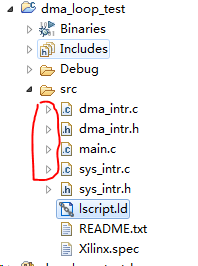本篇笔记中的代码来自:米联科技的教程“第三季第一篇的DMA_LOOP环路测试”
硬件的连接如下图所示:

图:DMA Loop Block Design
橘色的线就是DMA加FIFO组成的一个LOOP循环,红色圈圈是AXI_LITE的控制和两个读写完成的中断。
米联科技教程提供的该测试代码文件是以下四个,我删除了其中关于OLED的部分。

图:DMA Loop 测试源码结构
1.重要的结构体
1.1.中断设备:static XScuGic Intc; //GIC
在main.c文件中,sataic用来修饰全局变量,形成静态全局变量,static修饰的函数/全局变量属于内链接,Intc可以在当前main.c文件内部范围内进行链接。
/** * The XScuGic driver instance data. The user is required to allocate a * variable of this type for every intc device in the system. A pointer * to a variable of this type is then passed to the driver API functions. */ typedef struct { XScuGic_Config *Config; /**< Configuration table entry */ u32 IsReady; /**< Device is initialized and ready */ u32 UnhandledInterrupts; /**< Intc Statistics */ } XScuGic;
XScuGic结构体中包含了XScuGic_Config 结构体类型指针Config。XScuGic_Config 结构体如下:
typedef struct { u16 DeviceId; /**< Unique ID of device */ u32 CpuBaseAddress; /**< CPU Interface Register base address */ u32 DistBaseAddress; /**< Distributor Register base address */ XScuGic_VectorTableEntry HandlerTable[XSCUGIC_MAX_NUM_INTR_INPUTS];/**< Vector table of interrupt handlers */ } XScuGic_Config;
1.2.DMA设备:static XAxiDma AxiDma;
/** * The XAxiDma driver instance data. An instance must be allocated for each DMA * engine in use. */ typedef struct XAxiDma { UINTPTR RegBase; /* Virtual base address of DMA engine */ int HasMm2S; /* Has transmit channel */ int HasS2Mm; /* Has receive channel */ int Initialized; /* Driver has been initialized */ int HasSg; XAxiDma_BdRing TxBdRing; /* BD container management for TX channel */ XAxiDma_BdRing RxBdRing[16]; /* BD container management for RX channel */ int TxNumChannels; int RxNumChannels; int MicroDmaMode; int AddrWidth; /**< Address Width */ } XAxiDma;
1.3.中断向量表
typedef struct { Xil_ExceptionHandler Handler; void *Data; } XExc_VectorTableEntry;
2.代码结构
main()
|---- init_intr_sys();
|---- DMA_Intr_Init(); // 初始化DMA
|---- XAxiDma_LookupConfig(); // 查找DMA设备
|---- XAxiDma_CfgInitialize(); // 初始化DMA设备
|---- Init_Intr_System(); //初始化中断控制器
|---- XScuGic_LookupConfig(); // 查找中断控制器设备;带的参数为设备ID,查看中断向量是否存在
|---- XScuGic_CfgInitialize(); // 初始化中断控制器设备
|---- Setup_Intr_Exception();
|---- Xil_ExceptionInit(); // 使能硬件中断
|---- Xil_ExceptionRegisterHandler();
|---- Xil_ExceptionEnable();
|---- DMA_Setup_Intr_System(); // 设置DMA中断
|---- XScuGic_SetPriorityTriggerType();
|---- XScuGic_Connect(); // 连接中断源
|---- XScuGic_Enable();
|---- DMA_Intr_Enable();
|---- XAxiDma_IntrDisable();
|---- XAxiDma_IntrEnable();
|----axi_dma_test();
2.1.比较重要的函数
2.1.1.中断注册函数 Xil_ExceptionRegisterHandler:
/*****************************************************************************/ /** * @brief Register a handler for a specific exception. This handler is being * called when the processor encounters the specified exception. * * @param exception_id contains the ID of the exception source and should * be in the range of 0 to XIL_EXCEPTION_ID_LAST. * See xil_exception.h for further information. * @param Handler to the Handler for that exception. * @param Data is a reference to Data that will be passed to the * Handler when it gets called. * * @return None. * * @note None. * ****************************************************************************/ void Xil_ExceptionRegisterHandler(u32 Exception_id, Xil_ExceptionHandler Handler, void *Data) { XExc_VectorTable[Exception_id].Handler = Handler; XExc_VectorTable[Exception_id].Data = Data; }
从上面可以看到Xil_ExceptionRegisterHandler()这个函数是把中断的句柄(第二个行参“Handler”)和中断的参数(第三个行参“Data”)放到了两个结构体XExc_VectorTableEntry类型的数组XExc_VectorTable当中 ,XExc_VectorTableEntry结构体类型如下:
XExc_VectorTableEntry XExc_VectorTable[XIL_EXCEPTION_ID_LAST + 1] = { {Xil_ExceptionNullHandler, NULL}, {Xil_UndefinedExceptionHandler, NULL}, {Xil_ExceptionNullHandler, NULL}, {Xil_PrefetchAbortHandler, NULL}, {Xil_DataAbortHandler, NULL}, {Xil_ExceptionNullHandler, NULL}, {Xil_ExceptionNullHandler, NULL}, };
Xil_ExceptionRegisterHandler()函数的第二传参XScuGic_InterruptHandler,是一个函数指针,强制转化成了Xil_ExceptionHandler类型,XScuGic_InterruptHandler()函数如下。
void XScuGic_InterruptHandler(XScuGic *InstancePtr) { u32 InterruptID; u32 IntIDFull; XScuGic_VectorTableEntry *TablePtr; /* Assert that the pointer to the instance is valid */ Xil_AssertVoid(InstancePtr != NULL); /* * Read the int_ack register to identify the highest priority interrupt ID * and make sure it is valid. Reading Int_Ack will clear the interrupt in the GIC. * 读取 int_ack 寄存器以识别最高优先级的中断 ID, 并确保其有效。读取 Int_Ack 将清除 GIC 中的中断。
* 然后看看读出来的中断 ID 是否大于最大的中断值。 */ IntIDFull = XScuGic_CPUReadReg(InstancePtr, XSCUGIC_INT_ACK_OFFSET); InterruptID = IntIDFull & XSCUGIC_ACK_INTID_MASK; if(XSCUGIC_MAX_NUM_INTR_INPUTS < InterruptID){ goto IntrExit; } /* * Execute the ISR. Jump into the Interrupt service routine based on the * IRQSource. A software trigger is cleared by the ACK. */ TablePtr = &(InstancePtr->Config->HandlerTable[InterruptID]); if(TablePtr != NULL) { TablePtr->Handler(TablePtr->CallBackRef); } IntrExit: /* * Write to the EOI register, we are all done here. * Let this function return, the boot code will restore the stack. */ XScuGic_CPUWriteReg(InstancePtr, XSCUGIC_EOI_OFFSET, IntIDFull); }
通过程序开头 xilinx 给出的这个XScuGic_InterruptHandler()程序的注释可以知道: 这个函数是基本的中断驱动函数。 它必须 连接到中断源, 以便在中断控制器的中断激活时被调用。 它将解决哪些中断是活动的和启用的, 并调用适当的中断处理程序。 它使用中断类型信息来确定何时确认中断。 首先处理最高优先级的中断。 此函数假定中断向量表已预先初始化。 它不会在调用中断处理程序之前验证表中的条目是否有效。 当中断发生时,调用的就是上面的代码中的语句:TablePtr->Handler(TablePtr->CallBackRef)。那么这个Handler和CallBackRef到底是什么呢?也就是Handler和CallBackRef到底是和哪段要被执行的代码绑定在一起呢?
2.1.2.中断连接函数
我们在DMA_Setup_Intr_System()函数中调用了中断连接函数XScuGic_Connect();
int DMA_Setup_Intr_System(XScuGic * IntcInstancePtr,XAxiDma * AxiDmaPtr, u16 TxIntrId, u16 RxIntrId) { <...> /* * Connect the device driver handler that will be called when an * interrupt for the device occurs, the handler defined above performs * the specific interrupt processing for the device. */ Status = XScuGic_Connect(IntcInstancePtr, TxIntrId, (Xil_InterruptHandler)DMA_TxIntrHandler, AxiDmaPtr); if (Status != XST_SUCCESS) { return Status; } Status = XScuGic_Connect(IntcInstancePtr, RxIntrId, (Xil_InterruptHandler)DMA_RxIntrHandler, AxiDmaPtr); if (Status != XST_SUCCESS) { return Status; } <...> }
可以看到XScuGic_Connect()函数的第三个传参是一个Xil_InterruptHandler类型的函数指针DMA_TxIntrHandler。XScuGic_Connect()内容如下。
s32 XScuGic_Connect(XScuGic *InstancePtr, u32 Int_Id, Xil_InterruptHandler Handler, void *CallBackRef) { /* * Assert the arguments */ Xil_AssertNonvoid(InstancePtr != NULL); Xil_AssertNonvoid(Int_Id < XSCUGIC_MAX_NUM_INTR_INPUTS); Xil_AssertNonvoid(Handler != NULL); Xil_AssertNonvoid(InstancePtr->IsReady == XIL_COMPONENT_IS_READY); /* * The Int_Id is used as an index into the table to select the proper * handler */ InstancePtr->Config->HandlerTable[Int_Id].Handler = Handler; InstancePtr->Config->HandlerTable[Int_Id].CallBackRef = CallBackRef; return XST_SUCCESS; }
可以看到XScuGic_Connect()函数将传进来的第三个参数,Xil_InterruptHandler类型的“Handler”,绑定到InstancePtr->Config->HandlerTable[Int_Id].Handler中,第四个参数同理绑定。这里的InstancePtr是函数XScuGic_Connect()传进来的XScuGic结构体类型的指针变量,前面讲过,XScuGic结构体中还包含XScuGic_Config结构体类型的指针Config,进一步来说,XScuGic_Connect()函数将传进来的第三个参数Handler就是绑定到XScuGic_Config结构体类型的指针Config中的HandlerTable变量。这个HandlerTable变量是一个XScuGic_VectorTableEntry类型的结构体变量。至此,中断的Handler就绑定到main.c文件开头定义的设备static XScuGic Intc当中,同时设备 XScuGic Intc也因为函数Setup_Intr_Exception()跟硬件的异常向量表绑定到一起了。前文提到“Handler和CallBackRef到底是和哪段要被执行的代码绑定在一起呢?”,那么答案就在这里了,要执行的代码就在这里被绑定到一起来。
所以接下来看看这个形参Handler(对应的是调用XScuGic_Connect()函数传进来的实参DMA_TxIntrHandler)指向了什么东西?
函数指针DMA_TxIntrHandler指向的内容如下。下面代码是DMA Tx的,Rx的也差不多。
static void DMA_TxIntrHandler(void *Callback) { u32 IrqStatus; int TimeOut; XAxiDma *AxiDmaInst = (XAxiDma *)Callback; /* Read pending interrupts */ IrqStatus = XAxiDma_IntrGetIrq(AxiDmaInst, XAXIDMA_DMA_TO_DEVICE); /* Acknowledge pending interrupts */ XAxiDma_IntrAckIrq(AxiDmaInst, IrqStatus, XAXIDMA_DMA_TO_DEVICE); /* * If no interrupt is asserted, we do not do anything */ if (!(IrqStatus & XAXIDMA_IRQ_ALL_MASK)) { return; } /* * If error interrupt is asserted, raise error flag, reset the * hardware to recover from the error, and return with no further * processing. */ if ((IrqStatus & XAXIDMA_IRQ_ERROR_MASK)) { Error = 1; /* * Reset should never fail for transmit channel */ XAxiDma_Reset(AxiDmaInst); TimeOut = RESET_TIMEOUT_COUNTER; while (TimeOut) { if (XAxiDma_ResetIsDone(AxiDmaInst)) { break; } TimeOut -= 1; } return; } /* * If Completion interrupt is asserted, then set the TxDone flag */ if ((IrqStatus & XAXIDMA_IRQ_IOC_MASK)) { TxDone = 1; } }
代码中,在dma_intr.h中声明了三个全局变量:TxDone,RxDone和Error。
dam_intr.h :
extern volatile int TxDone; extern volatile int RxDone; extern volatile int Error;
在dma_intr.c文件的开头,定义了这三个全局变量。
#include "dma_intr.h" volatile int TxDone; volatile int RxDone; volatile int Error;
可以看到用关键字volatile修饰,在此回顾一下朱有鹏老师在讲解C语言的时候,总结的volatile的用法:
(1)volatile的字面意思:可变的、易变的。C语言中volatile用来修饰一个变量,表示这个变量可以被编译器之外的东西改变。编译器之内的意思是变量的值的改变是代码的作用,编译器之外的改变就是这个改变不是代码造成的,或者不是当前代码造成的,编译器在编译当前代码时无法预知。譬如在中断处理程序isr中更改了这个变量的值,譬如多线程中在别的线程更改了这个变量的值,譬如硬件自动更改了这个变量的值(一般这个变量是一个寄存器的值)
(2)以上说的三种情况(中断isr中引用的变量,多线程中共用的变量,硬件会更改的变量)都是编译器在编译时无法预知的更改,此时应用使用volatile告诉编译器这个变量属于这种(可变的、易变的)情况。编译器在遇到volatile修饰的变量时就不会对改变量的访问进行优化,就不会出现错误。
(3)编译器的优化在一般情况下非常好,可以帮助提升程序效率。但是在特殊情况(volatile)下,变量会被编译器想象之外的力量所改变,此时如果编译器没有意识到而去优化则就会造成优化错误,优化错误就会带来执行时错误。而且这种错误很难被发现。
(4)volatile是程序员意识到需要volatile然后在定义变量时加上volatile,如果你遇到了应该加volatile的情况而没有加程序可能会被错误的优化。如果在不应该加volatile而加了的情况程序不会出错只是会降低效率。所以我们对于volatile的态度应该是:正确区分,该加的时候加不该加的时候不加,如果不能确定该不该加为了保险起见就加上。
计划在xilinx DMA IP loop测试(二)中结合DMA的AXI4总线时序,来记录一下DMA的数据收发。